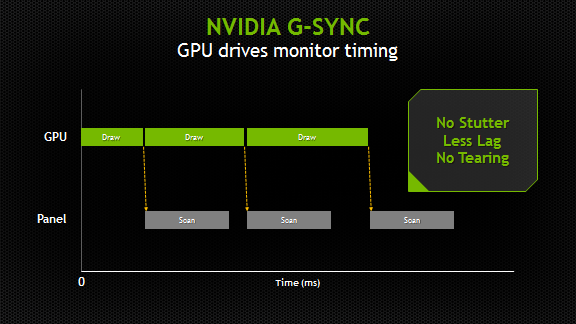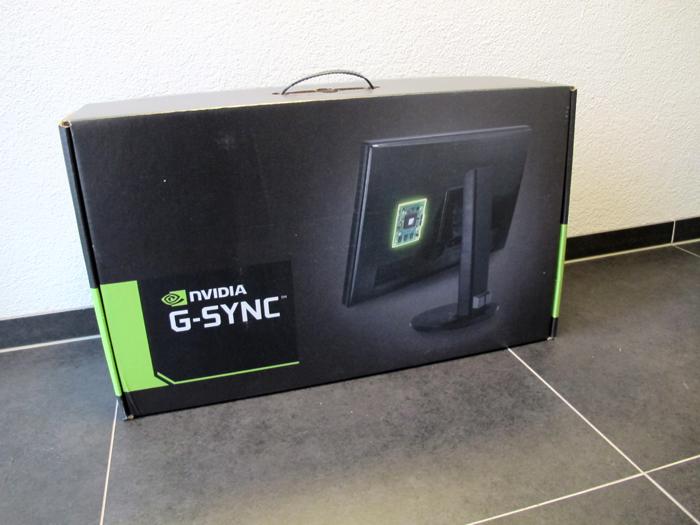G-Sync Explained
Salvation Has Arrived...
Nvidia has announced G-Sync, I explained two times already that the graphics card is running a dynamic device and that the monitor is static Hz, these two don't really match together. Now the irony is that the solution to solve all this is so very simple in its bare essence. G-Sync is both a software and a hardware solution that will get rid of screen tearing and sync stuttering/pulsing. A daughter hardware board (it actually does look a little like a mobile MXM module) is placed into a G-Sync enabled and capable monitor which will do something very interesting.
With G-Sync the monitor will become a slave to your graphics card as the its refresh rate in Hz becomes dynamic. Yes, it is no longer functioning in a static fashion. Each time your graphics card has rendered one frame (one draw) that frame is aligned up with the monitor refresh rate (scan). So the refresh rate of the monitor has become dynamic and is now synchronised with the GPU. With both the graphics card and monitor both dynamically in sync you have effectively eliminated stutter, input lag and screen tearing. It gets even better, without stutter and screen tearing on an nice IPS LCD panel even at say 35 Hz you'd be having an pretty good gaming experience (visually).
Now the first monitors might be TN screens like uses today, but monitors up-to 177 hz will get supported with Gsync as well as 4K monitors and IPS and LED. We'll use a 144 Hz TN panel based monitor in this initial article.The initial product cycle will only support display port 1.2 and higher though. At this time HDMI is not supported.
So in very short wording: NVIDIA G-SYNC is a solution that pretty much eliminates screen tearing, VSync input lag, and stutter. You need a G-SYNC module inside the monitor, the G-SYNC module will synchronize the monitor refresh rate to the output of the GPU, instead of the GPU to the monitor. That will result into a tear-free, faster, smoother experience. G-sync is both a hardware and software solution, on the software side of things G-Sync must be enabled in the NV control panel and the application profile must be set to G-Sync. We'll show you that later on in the article.
Are There Any Concerns?
Not a lot really. But sure, low FPS could get nasty as say 20 FPS on a LCD panel would look like weird. Now 20 FPS doesn't mean that your panel will flicker at 20 Hz as LCDs do not flicker. Unlike CRTs which have physical refresh rate. Even if your video card gives 3 frames per sec, it would be a slideshow, but it should be a pretty nice one. When a new frame arrives, it will be drawn in say 2ms, or 1ms according to monitor specs. In an optimal situation you will need a graphics card that can stay above 30~35 FPS as minimum.
A second concern could be lifespan, dynamically altering the Hz refresh rate on your monitor just has to put some load on the monitor hardware, it MIGHT have an effect on your monitors lifespan but I honestly do not have a definitive answer to that. Last but not least. G-Sync is Nvidia proprietary technology and thus only works with selected Nvidia GeForce Graphics cards and monitors. You can see the first monitors and upgrade kits in Q4 2013 / Q1 2014. One current ASUS model actually can be updated where (ASUS VG248QE) you can insert the G-Sync hardware yourself. G-Sync is going to included into monitors from ASUS, BenQ, Philips and ViewSonic. There are some additional limitations as well, GSYNC can be used with an SLI system but G-SYNC can’t operate in Windowed Mode (for now), currently it doesn't support NVIDIA’s Surround multi monitor technology either.
Will This Be An NVIDIA Only Enabled Feature?
For now, yes. Currently these graphics cards will be G-Sync compatible: GTX TITAN, GTX 780 (Ti), GTX 770, GTX 760, GTX 690, GTX 680, GTX 670, GTX 660 Ti, GTX 660, GTX 650 Ti Boost. You need to be running Windows 7 or higher as operating system.




